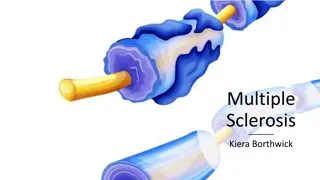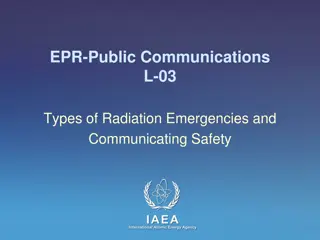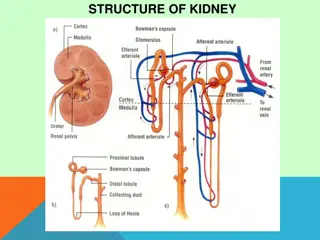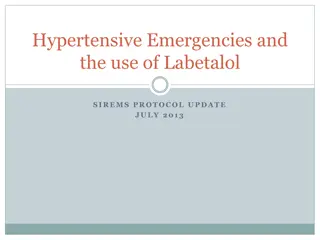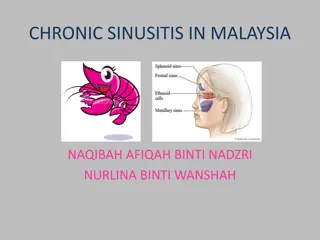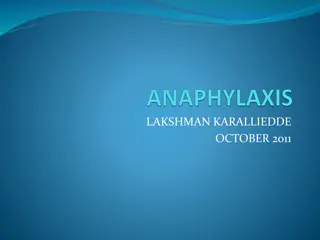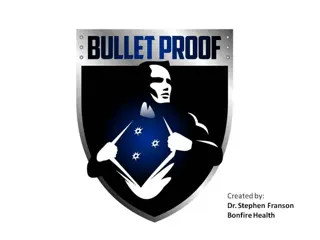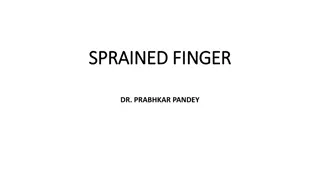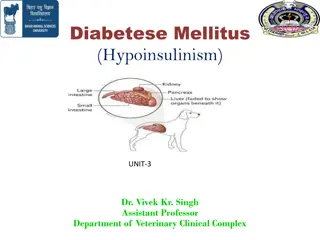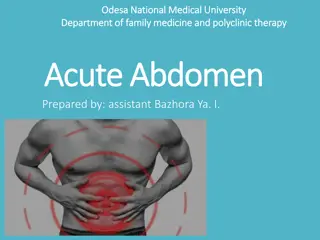Urological Emergencies: Causes, Symptoms & Treatment
Discover the different types of urological emergencies, both traumatic and non-traumatic, including hematuria, renal colic, urinary retention, acute scrotum, and more. Learn about the causes, symptoms, and immediate treatments required for these urgent urological conditions. Find out how to identify and manage renal colic, a common and painful emergency often caused by kidney stones. Explore the importance of rapid diagnosis and prompt intervention in addressing urological emergencies.
Download Presentation

Please find below an Image/Link to download the presentation.
The content on the website is provided AS IS for your information and personal use only. It may not be sold, licensed, or shared on other websites without obtaining consent from the author.If you encounter any issues during the download, it is possible that the publisher has removed the file from their server.
You are allowed to download the files provided on this website for personal or commercial use, subject to the condition that they are used lawfully. All files are the property of their respective owners.
The content on the website is provided AS IS for your information and personal use only. It may not be sold, licensed, or shared on other websites without obtaining consent from the author.
E N D
Presentation Transcript
UROLOGICAL EMERGENCIES Mete Kilciler, MD Professor Bah esehir University Department of Urology
UROLOGY DEAL WITH GENITAL AND URINARY SYSTEM IN MEN URINARY SYSTEM IN WOMEN
There are a lot of urologic emergencies and most of them are not life threatening But urologic emergencies require rapid diagnosis and immediate treatment
Urological Emergencies 1) Non traumatic 1. Hematuria 2. Renal Colic 3. Urinary Retention 4. Acute Scrotum 5. Priapism 2) Traumatic 1) Renal Trauma 2) Ureteral Injury 3) Bladder Trauma 4) Urethral Injury 5) Testicular Trauma 6) Penile Fracture
Urological Emergencies 1) Non traumatic 1. Hematuria 2. Renal Colic 3. Urinary Retention 4. Acute Scrotum 5. Priapism 2) Traumatic 1) Renal Trauma 2) Ureteral Injury 3) Bladder Trauma 4) Urethral Injury 5) Testicular Trauma 6) Penile fracture
Hematuria Blood in the urine Types: Macroscopic or microscopic Painless or painful Initial / Terminal / Total
Non traumatic emergency Hematuria Causes Nephrological (medical) or Urological (surgical)
Urological Emergencies 1) Non traumatic 1. Hematuria 2. Renal Colic 3. Urinary Retention 4. Acute Scrotum 5. Priapism 2) Traumatic 1) Renal Trauma 2) Ureteral Injury 3) Bladder Trauma 4) Urethral Injury 5) Testicular Trauma 6) Penile fracture
RENAL COLIC (ACUTE FLANK PAIN) The commonest urologic emergency Sudden onset of severe pain in the flank area One of the commonest causes of the Acute Abdomen . Most often due to the passage of a stone formed in the kidney, down through the ureter.
Non traumatic emergency Renal colic . The pain is characteristically : very sudden onset colicky in nature Radiates to the groin as the stone passes into the lower ureter. May change in location, from the flank to the groin, (according to the the location of the ureteral stone) Associated with nausea / Vomiting
Non traumatic emergency Renal colic . Work Up : History Examination: patient want to move around, in an attempt to find a comfortable position.
Non traumatic emergency Renal colic . Radiological investigation : X ray graphy (DUSG) Abdominal US IVP (was) Helical CT MRI
Non traumatic emergency Renal colic . Treatment of the Stone: Temporary relief of the obstruction: Insertion of a JJ stent or percutaneous nephrostomy tube. Definitive treatment of a ureteric stone: ESWL. PCNL Ureteroscopy Open Surgery: very limited.
Urological Emergencies 1) Non traumatic 1. Hematuria 2. Renal Colic 3. Urinary Retention 4. Acute Scrotum 5. Priapism 2) Traumatic 1) Renal Trauma 2) Ureteral Injury 3) Bladder Trauma 4) Urethral Injury 5) Testicular Trauma
Non traumatic emergency Urinary Retention Acute Urinary retention Chronic Urinary retention
Non traumatic emergency Acute Urinary retention Painful inability to void, with relief of pain following drainage of the bladder by catheterization. Pathophysiology: Increased urethral resistance, i.e., bladder outlet obstruction (BOO) Low bladder pressure, i.e., impaired bladder contractility Interruption of sensory or motor innervations of the bladder
Non traumatic emergency Acute urinary retention Causes : Men: Benign prostatic enlargement (BPE) due to BPH Carcinoma of the prostate Urethral stricture Prostatic abscess Women Pelvic prolapse (cystocoele, rectocoele,) Urethral stricture; Urethral diverticulum; Post surgery for stress incontinence pelvic masses (e.g., ovarian masses)
Non traumatic emergency Acute urinary retention Initial Management : Urethral catheterisation Suprapubic catheter ( SPC) Late Management: Treating the underlying cause
Chronic urinary retention Non traumatic emergency Obstruction develops slowly, the bladder is distended very gradually over weeks/months, so pain is not a feature . Presentation: Urinary dribbling Overflow incontinence Palpable lower suprapubic mass
Non traumatic emergency Chronic urinary retention Usually associated with Reduced renal function. Upper tract dilatation Bladder drainage under slow rate to avoid sudden decompression> hematuria.
Urological Emergencies 1) Non traumatic 1. Hematuria 2. Renal Colic 3. Urinary Retention 4. Acute Scrotum 5. Priapism 2) Traumatic 1) Renal Trauma 2) Ureteral Injury 3) Bladder Trauma 4) Urethral Injury 5) Testicular Trauma
Non traumatic emergency Acute Scrotum Emergency situation requiring prompt evaluation, differential diagnosis, and potentially immediate surgical exploration
Acute scrotum Differential Diagnosis Non traumatic emergency 1. Torsion of the Spermatic Cord Most serious. 2. Torsion of the Testicular and Epididymal Appendages. 3. Epididymitis. Most common
Non traumatic emergency Torsion of the Spermatic Cord Click to see larger picture (A) extravaginal; (B) intravaginal
Torsion of the Spermatic Cord (Intravaginal) Surgical emergency Irreversible ischemic injury to the testicular parenchyma may begin as soon as 4 hours Testicular Torsion
Non traumatic emergency Torsion of the Spermatic Cord Presentation: Acute onset of scrotal pain.
Torsion of the Spermatic Cord Physical examination: Non traumatic emergency The affected testis is high riding transverse orientation. Acute hydrocele or massive scrotal edema Click to see larger picture
Torsion of the Spermatic Cord Color Doppler ultrasound: Assessment of anatomy and determining the presence or absence of blood flow.
Non traumatic emergency Epid.Orchitis Presentation: Scrotal swelling, erythema, and pain. Dysuria and fever is more common Localized epididymal tenderness, a swollen and tender epididymis,
Non traumatic emergency Epid.Orchitis Management: parenteral antibiotic therapy should be given when UTI is documented or suspected. Scrotal elevation, the use of an athletic supporter
Urological Emergencies 1) Non traumatic 1. Hematuria 2. Renal Colic 3. Urinary Retention 4. Acute Scrotum 5. Priapism 2) Traumatic 1) Renal Trauma 2) Ureteral Injury 3) Bladder Trauma 4) Urethral Injury 5) Testicular Trauma
Non traumatic emergency Priapism Persistent erection of the penis for more than 4 hours that is not related or accompanied by sexual desire.
Priapism 2 Types: ischaemic (veno-occlusive, low flow (most common) Due to haematological disease, malignant infiltration of the corpora cavernosa with malignant disease, or drugs. Painful. nonischaemic (arterial, high flow). Due to perineal trauma, which creates an arteriovenous fistula. Painless
Non traumatic emergency Priapism Causes: Primary (Idiopathic) : 30%- 50% Secondary: Drugs Trauma Neurological Hematological disease Tumors Miscellaneous
Non traumatic emergency Priapism The diagnosis Usually obvious from the history Duration of erection >4 hours? Is it painful or not?. Previous history and treatment of priapism ? Identify any predisposing factors and underlying cause
Priapism Colour flow duplex ultrasonography in cavernosal arteries: Ischaemic (inflow low ) Nonischaemic (inflow normal ) Penile pudendal arteriography
Non traumatic emergency Priapism Treatment: Depends on the type of priapism. Conservative treatment should first be tried Medical treatment Surgical treatment. Treatment of underlying cause It is important to warn all patients with priapism of the possibility of impotence.
Urological Emergencies 1) Non traumatic 1. Hematuria 2. Renal Colic 3. Urinary Retention 4. Acute Scrotum 5. Priapism 2) Traumatic 1) Renal injuries 2) Ureteral injuries 3) Bladder injuries 4) Urethral Injuries 5) Testicular injuries 6) Penile fracture
Traumatic emergency RENAL INJURIES The kidneys relatively protected from traumatic injuries. Considerable degree of force is usually required to injure a kidney.
Mechanisms and cause: Blunt direct blow or acceleration/ deceleration (road traffic accidents, falls from a height, fall onto flank) Penetrating knives, gunshots, iatrogenic, e.g., percutaneous nephrolithotomy (PCNL)
Traumatic emergency Renal injuries Indications for renal imaging: Macroscopic hematuria Penetrating chest, flank, and abdominal wounds A history of a rapid acceleration or deceleration
Traumatic emergency Renal injuries What Imaging Study? Contrast-enhanced CT: accurate, rapid, images other intra-abdominal structures Renal us IVU
Traumatic emergency Renal injuries Staging (Grading) American Association for the Surgery of Trauma Organ Injury Severity Scale
Traumatic emergency Renal injuries Management: Conservative: Over 95% of blunt injuries
Traumatic emergency Renal injuries Surgical exploration: Persistent bleeding (persistent tachycardia and/or hypotension) Expanding perirenal haematoma Pulsatile perirenal haematoma
Urological Emergencies 1) Non traumatic 1. Hematuria 2. Renal Colic 3. Urinary Retention 4. Acute Scrotum 5. Priapism 2) Traumatic 1) Renal injuries 2) Ureteral injuries 3) Bladder injuries 4) Urethral Injuries 5) Testicular injuries
Traumatic emergency URETERIC INJURIES The ureters are protected from external trauma by surrounding bony structures, muscles and other organs Causes and Mechanisms : External Trauma Internal Trauma
Traumatic emergency Ureteric injuries External Trauma: Rare Severe force is required Blunt or penetrating. Blunt external trauma severe enough to injure the ureters will usually be associated with multiple other injuries Knife or bullet wound to the abdomen or chest may damage the ureter, as well as other organs.
Traumatic emergency Ureteric injuries Internal Trauma more common than external trauma Surgery: Hysterectomy, oophorectomy, and sigmoidcolectomy Ureteroscopy Caesarean section Aortoiliac vascular graft placement, Laparoscopic procedures, Orthopedic operations
Traumatic emergency Ureteric injuries Diagnosis: Requires a high index of suspicion Intraoperative: Late: 1. An ileus: the presence of urine within the peritoneal cavity 2. Prolonged postoperative fever or urinary sepsis 3. Persistent drainage of fluid from abdominal or pelvic drains, from the abdominal wound, or from the vagina. 4. Flank pain if the ureter has been ligated 5. An abdominal mass, representing a urinoma






